Czy kiedykolwiek próbowałeś wgrać plik na twoją witrynę WordPress i natrafiłeś na mur? To bardzo frustrujące, gdy nie możesz przesłać potrzebnego obrazka, wtyczki lub motywu. Nasi czytelnicy często proszą nas o pomoc w rozwiązywaniu problemów z przesyłaniem plików, ponieważ mogą one spowolnić twój przepływ pracy.
Czasami te limity przesyłania plików mogą nieoczekiwanie uniemożliwić dodawanie treści do biblioteki multimediów lub instalowanie większych wtyczek i motywów, których potrzebujesz. To tak, jakbyś miał związane ręce. A jest to jeszcze bardziej irytujące, gdy nie wiadomo, jak to naprawić!
Ale nie martw się, jesteśmy tutaj, aby pomóc. Uwielbiamy to, że WordPress jest tak konfigurowalną platformą i często istnieje wiele sposobów na rozwiązanie tego samego problemu.
W tym przewodniku pokażemy najprostsze sposoby na zwiększenie maksymalnego rozmiaru przesyłanych plików w WordPress. Dzięki temu będziesz mógł wrócić do tego, co kochasz – prowadzenia swojej witryny internetowej!
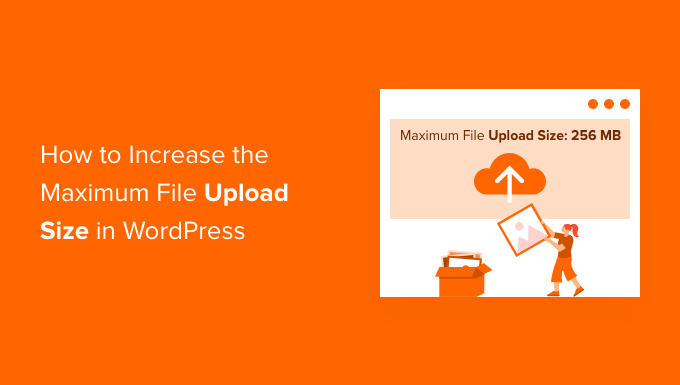
Dlaczego warto zwiększyć maksymalny rozmiar przesyłanego pliku w WordPress?
Twój dostawca hostingu WordPress ustawi domyślny maksymalny rozmiar przesyłanych plików podczas rejestracji i instalacji WordPressa. Twój dostawca hostingu definiuje ten limit i zwykle wynosi on od 2 MB do 500 MB.
Dla większości właścicieli witryn internetowych WordPress limit ten będzie więcej niż wystarczający.
Zdarzają się jednak sytuacje, w których konieczne będzie zwiększenie tego limitu, aby uniknąć błędów przesyłania.
Na przykład:
- Prowadzisz witrynę internetową poświęconą fotografii i musisz przesyłać duże obrazki.
- Twoje portfolio projektowe lub fotograficzne zawiera duże obrazki.
- Chcesz zainstalować większy motyw WordPress lub wtyczkę.
- Chcesz sprzedawać produkty cyfrowe, takie jak eBooki, zdjęcia, filmy i inne.
- Regularnie aktualizujesz treść i dodajesz pliki audio, zdjęcia i inne, które wykraczają poza obecny, aktualny limit.
Biorąc to pod uwagę, pokażemy ci, jak możesz zwiększyć maksymalny rozmiar przesyłanych plików na twojej witrynie WordPress.
Uwaga: Należy pamiętać, że wyświetlanie wielu dużych plików na twojej witrynie internetowej może poważnie spowolnić jej szybkość i wydajność. Dlatego też zazwyczaj zalecamy, aby nigdy nie przesyłać filmów do WordPressa.
Ponieważ większość użytkowników ma różne konfiguracje hostingu WordPress, omówimy następujące kwestie:
- How to Check Your Maximum File Upload Size Limit in WordPress
- Method 1: Contact Your WordPress Hosting Provider
- Method 2: Create or Edit an Existing php.ini file
- Method 3: Add Code to Your WordPress Theme functions.php File
- Method 4: Add Code to Your .htaccess File
- Method 5: Use a WordPress Plugin to Increase File Upload Size
Jak sprawdzić twój maksymalny limit rozmiaru przesyłanego pliku w WordPress?
WordPress automatycznie wyświetli maksymalny limit rozmiaru przesyłanego pliku podczas przesyłania obrazków lub innych multimediów.
Aby to sprawdzić, po prostu przejdź do Media ” Utwórz nowy w panelu administracyjnym WordPress, a zobaczysz maksymalny limit rozmiaru przesyłanego pliku dla twojej witryny WordPress.
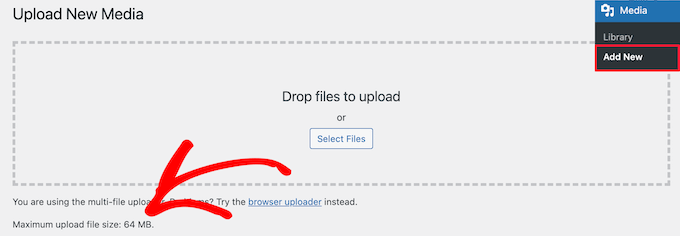
Teraz, gdy już wiesz, jak znaleźć limit rozmiaru, pokażemy Ci, jak zwiększyć maksymalny rozmiar przesyłania w WordPress.
Metoda 1: Skontaktuj się z dostawcą hostingu WordPress
Jednym z najprostszych sposobów na zwiększenie maksymalnego rozmiaru przesyłanych plików w WordPress jest skontaktowanie się z dostawcą hostingu WordPress.
Jest to stosunkowo proste zadanie dla ich zespołu obsługi klienta i można je wykonać w ciągu kilku minut.
Dla początkujących może to być znacznie łatwiejsze niż dodawanie kodu do WordPressa i edytowanie plików serwera.
Wystarczy przejść do witryny internetowej dostawcy hostingu, takiego jak Bluehost, i logować się.
Następnie kliknij ikonkę “Czat” u dołu ekranu. Następnie możesz poprosić pracowników pomocy technicznej o zwiększenie rozmiaru przesyłania plików na twojej witrynie WordPress.
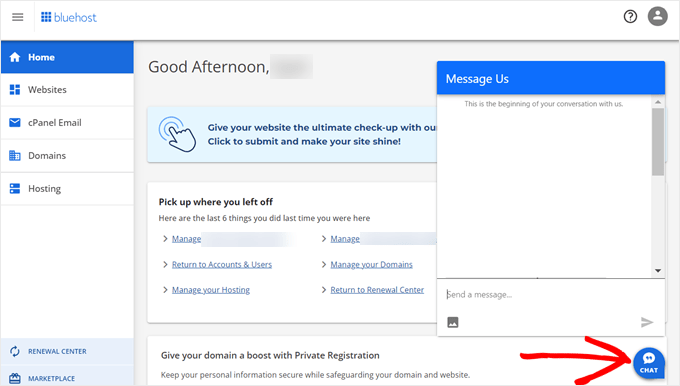
Możesz również skontaktować się z pomocą techniczną z poziomu kokpitu Twojego konta hostingowego.
Metoda 2: Utwórz lub edytuj istniejący plik php.ini
Innym sposobem na zwiększenie maksymalnego rozmiaru przesyłanego pliku jest utworzenie lub edycja pliku o nazwie php.ini. Plik ten kontroluje wiele ustawień dla twojego środowiska hostingowego WordPress.
Większość dostawców hostingu WordPress, takich jak Bluehost, ma przyjazny dla początkujących cPanel, który pomaga zarządzać twoją witryną internetową.
Jeśli twój hosting ma kokpit cPanel, możesz zwiększyć rozmiar przesyłanych plików za pomocą wbudowanych narzędzi.
Uwaga: Poniższe informacje pochodzą z cPanelu Bluehost. Jednak większość dostawców hostingu współdzielonego będzie miała podobne kroki.
Przycisk cPanel znajduje się w dolnej części karty Hosting w Bluehost.
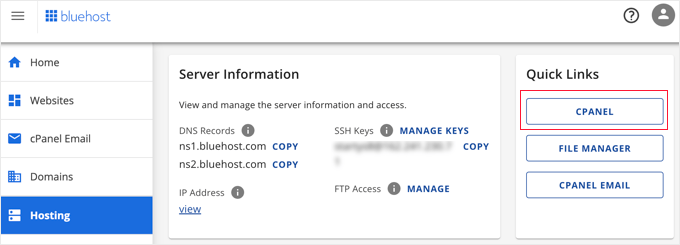
Kliknięcie tego przycisku otworzy twój kokpit cPanel.
Teraz należy przewinąć w dół do sekcji Oprogramowanie i kliknąć “MultiPHP INI Editor”.
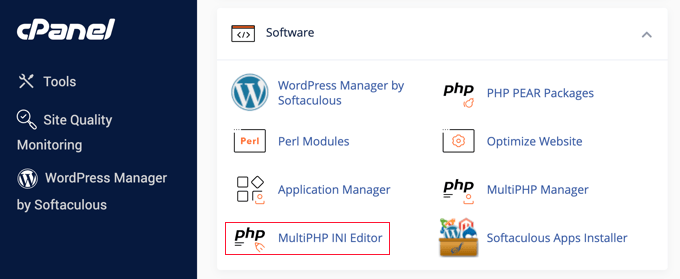
Następnie przewiń w dół do sekcji oznaczonej “upload_max_filesize” i wpisz nowy maksymalny rozmiar pliku w polu.
Następnie kliknij przycisk “Zastosuj”.
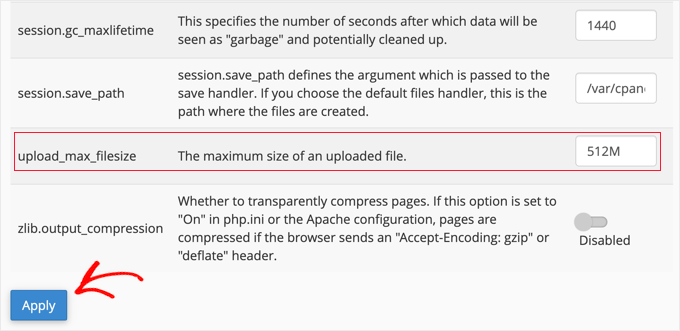
Alternatywnie można kliknąć kartę menu “Tryb edytora”, a następnie zmienić maksymalny rozmiar przesyłanego pliku bezpośrednio w edytorze.
Musisz edytować sekcję “upload_max_filesize”, aby zwiększyć twój rozmiar przesyłanego pliku.
Po zakończeniu kliknij przycisk “Zapisz”.
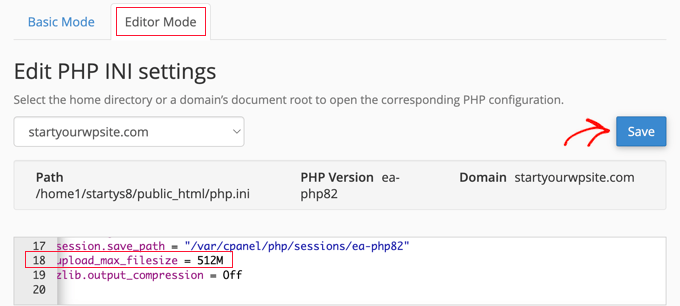
Edycja php.ini poprzez dodanie kodu
Jeśli twój obecny, aktualny dostawca hostingu nie oferuje opcji cPanel, będziesz musiał edytować ten plik ręcznie.
Aby to zrobić, możesz użyć klienta FTP lub opcji menedżera plików w twoim panelu sterowania hostingu WordPress.
Jeśli korzystasz z hostingu współdzielonego, możesz nie widzieć pliku php.ini w twoim katalogu hostingowym. Jeśli go nie widzisz, po prostu utwórz plik o nazwie php.ini i prześlij go do twojego katalogu głównego.
Następnie dodaj następujący fragment kodu do pliku:
1 2 3 | upload_max_filesize = 256Mpost_max_size = 256Mmax_execution_time = 300 |
Możesz zmodyfikować limit “256M” do rozmiaru pliku, którego potrzebujesz dla twojego bloga WordPress.
Metoda 3: Dodanie kodu do pliku functions.php twojego motywu WordPress
Metoda ta bierze udział w dodaniu kodu do pliku functions.php w twoim motywie WordPress.
Zamiast edytować plik bezpośrednio, zalecamy użycie WPCode. Jest to najlepsza wtyczka do fragmentów kodu, która umożliwia dodawanie kodu do twojej witryny internetowej bez jej niszczenia.
Jeśli nie robiłeś tego wcześniej, zapoznaj się z naszym przewodnikiem dla początkujących, jak dodać własny kod w WordPress.
Najpierw należy zainstalować darmową wtyczkę WPCode. Aby uzyskać więcej informacji, zobacz nasz przewodnik krok po kroku, jak zainstalować wtyczkę WordPress.
Po włączaniu należy przejść do sekcji Fragmenty kodu ” + Dodaj fragment kodu.
Będziesz musiał najechać kursorem myszy na opcję “Add Your Custom Code (New Snippet)”, a następnie kliknąć przycisk “+ Add Custom Snippet”.

Następnie należy wybrać “Fragment kodu PHP” jako rodzaj kodu z wyświetlonej listy opcji.
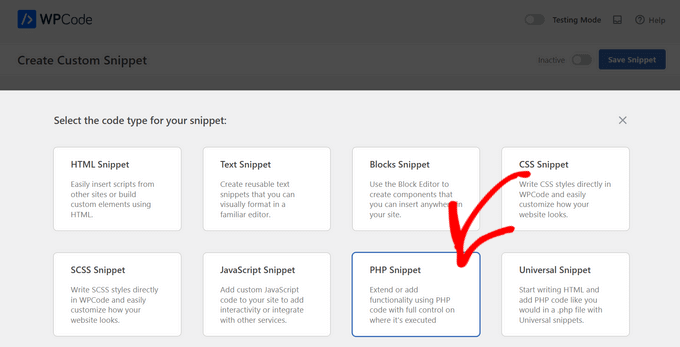
Na następnym ekranie wpisz nazwę twojego nowego fragmentu kodu, która może być dowolna, aby pomóc ci zapamiętać, do czego służy kod.
Następnie możesz skopiować i wkleić poniższy fragment kodu w sekcji “Podgląd kodu”. Upewnij się, że zmieniłeś “256M” na maksymalny wymagany rozmiar pliku:
1 2 3 | @ini_set( 'upload_max_size' , '256M' );@ini_set( 'post_max_size', '256M');@ini_set( 'max_execution_time', '300' ); |
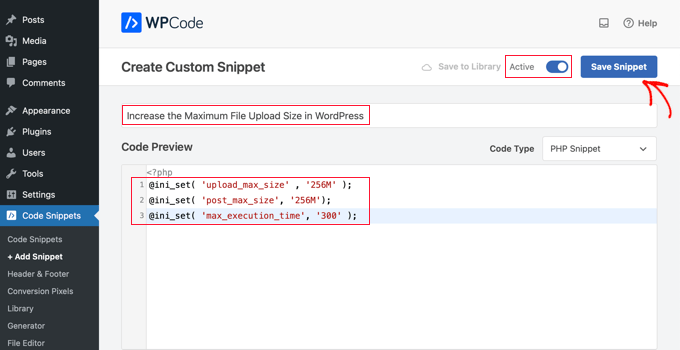
Na koniec przełącz przełącznik u góry na “Włączony”, a następnie kliknij przycisk “Zapisz fragment kodu”. Kod zostanie teraz wykonany na twojej witrynie internetowej.
Metoda 4: Dodaj kod do twojego pliku .htaccess
Innym sposobem na zwiększenie maksymalnego rozmiaru pliku jest modyfikacja pliku .htaccess. Plik ten kontroluje wysokopoziomowe ustawienia konfiguracyjne twojej witryny internetowej.
Aby to zrobić, musisz logować się na twój serwer witryny internetowej przez FTP. Jeśli nie robiłeś tego wcześniej, zapoznaj się z naszym przewodnikiem na temat korzystania z FTP do przesyłania plików do WordPressa dla początkujących.
Następnie należy zlokalizować plik .htaccess w katalogu głównym witryny internetowej.

Jeśli nie możesz znaleźć twojego pliku .htaccess, może on być ukryty przez menedżera plików lub klienta FTP. Aby dowiedzieć się więcej, zobacz nasz przewodnik na temat tego, dlaczego nie możesz znaleźć pliku .htaccess na twojej witrynie WordPress.
Następnie musisz dodać następujący fragment kodu do twojego pliku .htaccess:
1 2 3 4 | php_value upload_max_filesize 256Mphp_value post_max_size 256Mphp_value max_execution_time 300php_value max_input_time 300 |
Aby jeszcze bardziej zwiększyć twój maksymalny rozmiar przesyłanego pliku, po prostu zmień “64M” na wymagany rozmiar.
Metoda 5: Użyj wtyczki WordPress, aby zwiększyć rozmiar przesyłanego pliku
Innym sposobem na zwiększenie maksymalnego limitu przesyłania plików jest użycie wtyczki WP Increase Upload Filesize. Jeśli nie czujesz się komfortowo dodając kod do WordPressa, może to być dobra opcja dla Ciebie.
Pierwszą rzeczą, którą musisz zrobić, jest zainstalowanie i włączanie wtyczki. Więcej szczegółów można znaleźć w naszym przewodniku na temat instalacji wtyczki WordPress.
Po włączaniu, przejdź do Media ” Increase Upload Limit w twoim panelu administracyjnym WordPress.
Spowoduje to wyświetlenie ekranu, na którym można wybrać nowy rozmiar przesyłanego pliku z listy rozwijanej “Wybierz maksymalny rozmiar przesyłanego pliku”.
Następnie kliknij przycisk “Zapisz zmiany”.

Uwaga: Maksymalny rozmiar przesyłanego pliku zostanie ustawiony przez twojego dostawcę hostingu. Jeśli potrzebujesz limitu rozmiaru pliku, który jest większy niż ten wymieniony w rozwijanym menu, musisz skontaktować się z dostawcą hostingu i poprosić o zwiększenie limitu.
Film instruktażowy
Jeśli nie lubisz postępować zgodnie z pisemnymi instrukcjami, możesz zapoznać się z naszym filmem instruktażowym:
Mamy nadzieję, że ten artykuł pomógł ci zwiększyć maksymalny rozmiar przesyłanego pliku w WordPress. Możesz również zapoznać się z naszym przewodnikiem na temat dodawania dodatkowych rodzajów plików do przesłania w WordPressie oraz naszymi eksperckimi wtyczkami i wskazówkami, aby ulepszyć obszar administracyjny WordPressa.
If you liked this article, then please subscribe to our YouTube Channel for WordPress video tutorials. You can also find us on Twitter and Facebook.





Dayo Olobayo
Thanks for showing how to check the default limit. Just checked mine now and saw it’s 1GB. I think that’s good enough for me so I won’t be touching anything. I must also add that the wpcode method would have been my preferred method if I needed to change anything.
Lisha Van Nieuwenhove
This help was BRILLIANT. THANK YOU!
WPBeginner Support
You’re welcome!
Admin
Ray Konopka
Thanks for the tips. My site is hosted in BlueHost so I first tried Method 2. However, after changing the upload_max_filesize value, the Add New media page for my site still showed 64 MB. I went back into the MultiPHP INI Editor and looked at the other values. One other value stood out:
post_max_size
Sets max size of post data allowed. This setting also affects file upload. To upload large files, this value must be larger than upload_max_filesize. Generally speaking, memory_limit should be larger than post_max_size.
After I increased the post_max_size value as well, then the Add New media upload page showed the new limit. Perhaps you can update the post to include this tip.
WPBeginner Support
Thank you for sharing this, we’ll be sure to look into it and possibly add it to the article in the future
Admin
Mark
All my limits were increased as suggested, but I started getting ‘files are too big’ after a plugin update. After double checking everything server and email side, the solution was changing from 5M to 5120kb in Contact Form 7 settings. The plugin suddenly stopped recognizing M when trying to override the default 1024kb setting.
WPBeginner Support
Thanks for sharing this should someone else run into this issue!
Admin
devshah
Function.php method is not Working.
WPBeginner Support
It would depend on your host and what else is set up on your server for what will work. If nothing else works you can always reach out to your host for assistance.
Admin
Halil AHMAD
The .htaccess worked for me. Thank you
Muzoora Barnabas
The .htaccess worked for me. Thank you
WPBeginner Support
Glad our recommendation was able to assist
Admin
Muhammad Farooqi
You comments and thanks secion is almost 10 times longer..than the content of this page is guarantee of your amazing tips
WPBeginner Support
We’re happy we can help so many WordPress users
Admin
Jacob Alas
The only method that worked for me was: htaccess Method
Thank you.
WPBeginner Support
Glad one of our methods was able to work for you
Admin
Daniyar Nauryz
htaccess Method has worked for me.
WPBeginner Support
Glad our recommendation worked for you
Admin
furqan
its not working.
WPBeginner Support
If the recommendations are not working for you, we would recommend reaching out to your hosting provider and they should be able to assist if this is something they’ve set on their end.
Admin
Abdullah Ashraf
Thank you so much. I tried all the methods and the last method was helpful for me.
I would like to know should I undo the second last step that was php.ini?
WPBeginner Support
It is not required to remove that file but you can remove it if it is not working for your server.
Admin
Bradley
None work.
WPBeginner Support
If none of our recommendations work, we would recommend reaching out to your hosting provider to see if it is a restriction that they have set on their servers.
Admin
Ben
If you have access to the FTP, can I just upload the file in the wp-content/uploads/[year]/[month] folder?
WPBeginner Support
If you do that you would need a plugin to find the images, we have a guide on how to do that below:
https://www.wpbeginner.com/plugins/how-to-bulk-upload-wordpress-media-files-using-ftp/
Admin
naved ahmed
Thanks a lot
.htaccess method worked for me.
You saved my lot of time.
Thanks again.
WPBeginner Support
Glad our guide was able to help you
Admin
Adio Usman
Does this method works for restoring backup that is up to 3.5gb manually?
WPBeginner Support
It would depend on the method you are using but it could help with restoring a backup that large.
Admin
viren
method 3 is perfectly worked for me.keep inspiring us.great work man.thnks
WPBeginner Support
Glad our recommendation was helpful
Admin
ayman
.htaccess methode worked with me
WPBeginner Support
Glad our recommendation was helpful
Admin
Sanchit Setia
Does this work on free hosting?
WPBeginner Support
You would want to check with your hosting provider if you are concerned
Admin
bara
It works for me
WPBeginner Support
Glad our recommendation helped you
Admin
abc
nothing is working for lms
WPBeginner Support
If none of the recommendations worked we would recommend reaching out to your hosting provider for assistance.
Admin
Ahmad
I tried this but the size did not change… status is same please help what should I do know I am using localhost
WPBeginner Support
You would want to try restarting your localhost service just in case, otherwise, you would want to ensure you added/editied the php.ini correctly for the most common reason.
Admin
Vittorio
I think
@ini_set( ‘upload_max_size’ , ’64M’ );
should be
@ini_set( ‘upload_max_filesize’ , ’64M’ );
WPBeginner Support
upload_max_size currently increases that value as well as a few other things which is why we don’t use upload_max_filesize
Admin
MFoale
Thank you. The 3rd method worked for me. Very useful post and video.
WPBeginner Support
You’re welcome, glad we were able to help
Admin
Masud Rana
Wow !its work. Thanks
WPBeginner Support
Glad our guide could help you
Admin
Oliver
IT WORKS!!! THANKS
I made a file ini.php then uploaded it, then renamed it from ini.php.txt to ini.php and it worked.
thanks
WPBeginner Support
You’re welcome, glad our guide was able to help
Admin
Brad
None of these works
WPBeginner Support
If our recommendations do not work you would want to reach out to your hosting provider to ensure they do not have it as part of their settings.
Admin
Arivazhagan
Method 2 worked for me thanks a lot ive been struggling with this for two days …
WPBeginner Support
You’re welcome, glad our recommended solution was able to help you
Admin
Sujan Chakraborty
you are great.I fix my problem by reading you post.Tnx
WPBeginner Support
Glad our article could be helpful
Admin
Krakawid
Method 3 worked
WPBeginner Support
Glad our recommendation worked for you
Admin
Tung
Method 1 worked wonders for me. Thanks a bunch!
WPBeginner Support
You’re welcome, glad our recommendation worked for you
Admin
Trasadu
Thanks Method 3 really worked for me.
WPBeginner Support
Glad our recommendation was helpful
Admin
Asad
How can i increase the upload limit while i have the wordpress hosting also functions.php isn’t updating
WPBeginner Support
If the file will not update, you would want to reach out to your hosting provider and they should be able to assist
Admin
Chris
I want to increase the limit to 250mb but i dont know if this exposes my site to security treats, though am only using gravity form and I have also set to disable php execution on my upload folder. And have allowed only jpg, and mp3 files.
Please do you think this may affect my site load times as huge upload is coming from several users?
WPBeginner Support
If multiple users attempt uploads at the same time it can have an effect on your site’s load time but it shouldn’t open you to security threats
Admin
Vinod
Thanks a lot!!! Method 3 worked for me
WPBeginner Support
Glad our recommendation worked for you
Admin
Janice
Nice article, but I tried adding your 3 lines of code to the functions.php file, but got an “unknown @ rule” error. What’s that all about?
WPBeginner Support
It would depend on the entire error but it could have been a hiccup with how the code was inserted, you may want to take a look at our guide here: https://www.wpbeginner.com/beginners-guide/beginners-guide-to-pasting-snippets-from-the-web-into-wordpress/
Admin
Abduaziz
Thanks a lot!!! Method 3 worked for me
WPBeginner Support
Glad our recommendation could help
Admin
Alexander Gartley
Thanks, this helped me troubleshoot an upload limit. I’m on a WordPress multisite network install, so it ended up being a setting in the Network Admin Settings.
I was confused at first, because my php settings were allowing larger uploads, but it was restricted in the Network Settings.
WPBeginner Support
Thanks for sharing what solved the problem for you
Admin
Ernesto
Would have been great if you have included the .user.ini method.
.user.ini uploaded in the root folder with the same value/text in your edited php.ini
Most of the time, only this method works for shared hosting.
ErnestPH
WPBeginner Support
The php.ini file should work the same as the user.ini file unless your specific host ignores the php.ini but thank you for sharing your recommendation
Admin
Mark
This is the only solution that works on my shared hosting server. Thanks Ernesto!
Tamir Davidoff
Not working for me.
I have followed this guide and double checked the php.ini file to make sure that the changed are in fact saved. changed htaccess file to increase limits. and also tried modifying the phpMyAdmin httpd-app.conf and php-settings.conf file. All of these files reflect max upload higher than 40m and my WP site does not reflect Any of these changes. Really frustrated here.
Please help me, thanks !
WPBeginner Support
If you haven’t already, you would want to reach out to your hosting provider to ensure there is not a setting on their end that is overriding what you are setting
Admin
rajesh
i have tried all 3 method none of them worked. i am trying to upload newspaper theme in my in my wordpress site. but every time it show that php.ini file upload max file size.
plz help me
WPBeginner Support
You would want to reach out to your hosting provider to ensure they don’t have a setting that is overriding the changes you made.
Admin
Adam Walsworth
Watchout for hidden php.ini files. In my setup I found 2 of them. The one which I found actually resolved the issue was found under
./etc/php/7.0/apache2/php.ini
modifying this file fixed my issue.
WPBeginner Support
Thanks for sharing your solution, with where that file is located we would recommend most users reach out to their hosting provider before looking in locations like that.
Admin
Rafiq khan
Thanks buddy i have solved my problem by adopting method 2 by editing my php.ini file
Thanks alot you are working great
WPBeginner Support
Glad our article could help
Admin
Carla
None of the above worked for me. A matter of fact, editing the htaccess file broke my site even after deleting the above code. Overwriting with a new file fixed the problem though.
I have a dedicated server on Bluehost. What worked for me was going in the WHM root, not cpanel nor FTP access. Search for MultiPHP INI Editor. Give it at least 5 minutes to load if you only see the title and icon. You can set you upload time, post size, etc. there. Works instantly, even if your site is using Cloudflare, without placing it in development mode or clearing the cache. I hope this helps someone.
WPBeginner Support
Thank you for sharing what worked for you, should other users be on a dedicated server, if they reach out and let BlueHost know the need to increase the upload size then BlueHost can normally edit that for them
Admin
Pezza
Great Stuff! .htaccess worked for me!
WPBeginner Support
Thank you, glad our guide could help
Admin
ReineR
htaccess metod worked for me, thanks!
WPBeginner Support
Glad our article could help
Admin
Ahmed
Work for me
3. htaccess Method
you need to click (show hidden files to view and edit this file).
WPBeginner Support
Glad our article could help
Admin
rahul
when i tried this
Unable to communicate back with site to check for fatal errors, so the PHP change was reverted. You will need to upload your PHP file change by some other means, such as by using SFTP.
this happened to me
whats the solution of this
WPBeginner Support
You would need to use FTP rather than WordPress itself to add the code: https://www.wpbeginner.com/beginners-guide/how-to-use-ftp-to-upload-files-to-wordpress-for-beginners/
Admin
Ephraim
I had been trying php.ini method but it never works please how will I set it..
Or you should please tell me the were to paste at function.php
WPBeginner Support
You would normally use a text editor to set the content in the php.ini file. For your functions.php it should go at the end normally so it can be removed later as needed. You may also want to check with your hosting provider if you are having trouble with these methods for if they can assist in increasing the file size for you.
Admin
Ivos G.
None worked for me. But this one fixed it – add to your .htaccess this line:
LimitRequestBody 104857600
WPBeginner Support
Thanks for sharing your solution for this issue
Admin